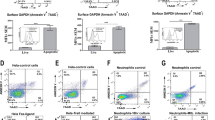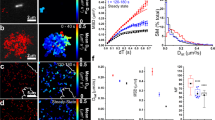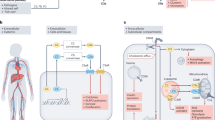Abstract
Recognition of phosphatidylserine (PtdSer) is essential for engulfment of apoptotic cells by mammalian phagocytes. Engagement of a new phosphatidylserine-specific receptor (PtdSerR) appears to be necessary for uptake of apoptotic cells. Many other mammalian receptors have been described to function in the clearance of apoptotic cells. The emerging picture is that many of these receptors may provide the strong adhesion needed to increase the likelihood of contact between the PtdSerR and its phospholipid ligand, which is required for uptake. Furthermore, stimulation of this receptor on different types of phagocytes by apoptotic cells, PtdSer-containing liposomes or an IgM monoclonal anti-PtdSer antibody initiates release of TGFβ, known to be involved in the anti-inflammatory effects of apoptotic cells. Although highly homologous genes exist in C. elegans and Drosophila melanogaster, their role in engulfment of apoptotic cells remains to be determined. Cell Death and Differentiation (2001) 8, 582–587
Similar content being viewed by others
Log in or create a free account to read this content
Gain free access to this article, as well as selected content from this journal and more on nature.com
or
Abbreviations
- β2GPI:
-
beta 2 glycoprotein 1
- BMDM:
-
bone marrow-derived macrophages
- HMDM:
-
human monocyte-derived macrophages
- LDL:
-
low density lipoprotein
- PAF:
-
platelet activating factor
- PGE2:
-
prostaglandin E2
- POP-L-PS:
-
1-palmitoyl-2-oleoyl-sn-3 glycerophospho-L-serine
- POP-D-PS:
-
1-palmitoyl-2-oleoyl-sn-3 glycerophospho-D-serine
- PtdSer:
-
phosphatidylserine
- PtdSerR:
-
phosphatidylserine receptor
- TGFβ:
-
transforming growth factor-beta
References
Fadok VA, de Cathelineau A, Daleke DL, Henson PM, Bratton DL . 2001 Loss of phospholipid asymmetry and surface exposure of phosphatidylserine is required for phagocytosis of apoptotic cells by macrophages and fibroblasts J. Biol. Chem. 276: 1071–1077
Dini L, Autuori F, Lentini A, Oliverio S, Piacentini M . 1992 The clearance of apoptotic cells in the liver is mediated by the asialoglycoprotein receptor FEBS Lett. 296: 174–178
Dini L, Lentini A, Diez GD, Rocha M, Falasca L, Serafino L, Vidal-Vanaclocha F . 1995 Phagocytosis of apoptotic bodies by liver endothelial cells J. Cell. Sci. 108: 967–973
Dini L . 1998 Endothelial liver cell recognition of apoptotic peripheral blood lymphocytes Biochem. Soc. Trans. 26: 635–639
Duvall E, Wyllie AH, Morris RG . 1985 Macrophage recognition of cells undergoing programmed cell death (apoptosis) Immunology 56: 351–358
Falasca L, Bergamini A, Serafino A, Balabaud C, Dini L . 1996 Human Kupffer cell recognition and phagocytosis of apoptotic peripheral blood lymphocytes Exp. Cell. Res. 224: 152–162
Savill J, Dransfield I, Hogg N, Haslett C . 1990 Vitronectin receptor-mediated phagocytosis of cells undergoing apoptosis Nature 343: 170–173
Savill J, Hogg N, Haslett C . 1991 Macrophage vitronectin receptor, CD36, and thrombospondin cooperate in recognition of neutrophils undergoing programmed cell death Chest 99: 6S–7S
Shiratsuchi A, Umeda M, Ohba Y, Nakanishi Y . 1997 Recognition of phosphatidylserine on the surface of apoptotic spermatogenic cells and subsequent phagocytosis by Sertoli cells of the rat J. Biol. Chem. 272: 2354–2358
Shiratsuchi A, Kawasaki Y, Ikemoto M, Arai H, Nakanishi Y . 1999 Role of class B scavenger receptor type I in phagocytosis of apoptotic rat spermatogenic cells by Sertoli cells J. Biol. Chem. 274: 5901–5908
Platt N, Suzuki H, Kurihara Y, Kodama T, Gordon S . 1996 Role for the class A macrophage scavenger receptor in the phagocytosis of apoptotic thymocytes in vitro Proc. Natl. Acad. Sci. USA 93: 12456–12460
Sambrano GR, Steinberg D . 1995 Recognition of oxidatively damaged and apoptotic cells by an oxidized low density lipoprotein receptor on mouse peritoneal macrophages: role of membrane phosphatidylserine Proc. Natl. Acad. Sci. USA 92: 1396–1400
Sambrano GR, Terpstra V, Steinberg D . 1997 Independent mechanisms for macrophage binding and macrophage phagocytosis of damaged erythrocytes. Evidence of receptor cooperativity Arterioscler. Thromb. Vasc. Biol. 17: 3442–3448
Oka K, Sawamura T, Kikuta K, Itokawa S, Kume N, Kita T, Masaki T . 1998 Lectin-like oxidized low-density lipoprotein receptor 1 mediates phagocytosis of aged/apoptotic cells in endothelial cells Proc. Natl. Acad. Sci. USA 95: 9535–9540
Devitt A, Moffatt OD, Rakundalia C, Capra JD, Simmons DL, Gregory CD . 1998 Human CD14 mediates recognition and phagocytosis of apoptotic cells Nature 392: 505–509
Flora PK, Gregory CD . 1994 Recognition of apoptotic cells by human macrophages: inhibition by a monocyte/macrophage-specific monoclonal antibody Eur. J. Immunol. 24: 2625–2632
Mevorach D, Mascarenhas JO, Gershov D, Elkon KB . 1998 Complement-dependent clearance of apoptotic cells by human macrophages J. Exp. Med. 188: 2313–2320
Schwartz BR, Karsan A, Bombeli T, Harlan JM . 1999 A novel beta 1 integrin-dependent mechanism of leukocyte adherence to apoptotic cells J. Immunol. 162: 4842–4848
Taylor PR, Carugati A, Fadok VA, Cook HT, Andrews M, Carroll MC, Savill JS, Henson PM, Botto M, Walport MJ . 2000 A hierarchical role for classical pathway complement proteins in the clearance of apoptotic cells in vivo J. Exp. Med. 192: 359–366
Botto M, Dell'Agnola C, Bygrave AE, Thompson EM, Cook HT, Petry F, Loos M, Pandolfi PP, Walport MJ . 1998 Homozygous C1q deficiency causes glomerulonephritis associated with multiple apoptotic bodies [see comments] Nat. Genet. 19: 56–59
Balasubramanian K, Chandra J, Schroit AJ . 1997 Immune clearance of phosphatidylserine-expressing cells by phagocytes. The role of beta2-glycoprotein I in macrophage recognition J. Biol. Chem. 272: 31113–31117
Balasubramanian K, Schroit AJ . 1998 Characterization of phosphatidylserine-dependent beta2-glycoprotein I macrophage interactions. Implications for apoptotic cell clearance by phagocytes J. Biol. Chem. 273: 29272–29277
Sauter B, Albert ML, Francisco L, Larsson M, Somersan S, Bhardwaj N . 2000 Consequences of cell death: exposure to necrotic tumor cells, but not primary tissue cells or apoptotic cells, induces the maturation of immunostimulatory dendritic cells [see comments] J. Exp. Med. 191: 423–434
Fadok VA, Bratton DL, Rose DM, Pearson A, Ezekowitz RA, Henson PM . 2000 A receptor for phosphatidylserine-specific clearance of apoptotic cells [see comments] Nature 405: 85–90
Nagase T, Ishikawa K-I, Miyajima N, Tanaka A, Kotani H, Nomura N, Ohara O . 1998 Prediction of the coding sequences of unidentified human genes. IX. The complete sequences of 100 new cDNA clones from brain which can code for large proteins in vitro DNA Res. 5: 31–39
Fadok VA, Savill JS, Haslett C, Bratton DL, Doherty DE, Campbell PA, Henson PM . 1992 Different populations of macrophages use either the vitronectin receptor or the phosphatidylserine receptor to recognize and remove apoptotic cells J. Immunol. 149: 4029–4035
Fadok VA, Laszlo DJ, Noble PW, Weinstein L, Riches DW, Henson PM . 1993 Particle digestibility is required for induction of the phosphatidylserine recognition mechanism used by murine macrophages to phagocytose apoptotic cells J. Immunol. 151: 4274–4285
Fadok VA, Warner ML, Bratton DL, Henson PM . 1998 CD36 is required for phagocytosis of apoptotic cells by human macrophages that use either a phosphatidylserine receptor or the vitronectin receptor (alpha v beta 3) J. Immunol. 161: 6250–6257
Pradhan D, Krahling S, Williamson P, Schlegel RA . 1997 Multiple systems for recognition of apoptotic lymphocytes by macrophages Mol. Biol. Cell. 8: 767–778
Krahling S, Callahan MK, Williamson P, Schlegel RA . 1999 Exposure of phosphatidylserine is a general feature in the phagocytosis of apoptotic lymphocytes by macrophages Cell Death Differ. 6: 183–189
Callahan MK, Williamson P, Schlegel RA . 2000 Surface expression of phosphatidylserine on macrophages is required for phagocytosis of apoptotic thymocytes Cell Death Differ. 7: 645–653
Lu PJ, Zhou XZ, Shen M, Lu KP . 1999 Function of WW domains as phosphoserine- or phosphothreonine-binding modules Science 283: 1325–1328
Igarashi K, Kaneda M, Yarnaji A, Saido TC, Kikkawa U, Ono Y, Inoue K, Umeda M . 1995 A novel phosphatidylserine binding peptide motif defined by an anti-idiotypic monoclonal antibody. Localization of phosphatidylserine-specific binding sites on protein kinase C and phosphatidylserine decarboxylase J. Biol. Chem. 270: 29075–29078
Tait J, Sakata M, McMullen BA, Miao CH, Funakoshi T, Hendrickson LE, Fujikawa K . 1988 Placental anticoagulant proteins: isolation and comparative characterization four members of the lipocortin family Biochemistry 27: 6268–6276
Funakoshi T, Hendrickson LE, McMullen BA, Fujikawa K . 1987 Primary structure of human placental anticoagulant protein Biochemistry 26: 8087–8092
Funakoshi T, Heimark RL, Hendrickson LE, McMullen BA, Fujikawa K . 1987 Human placental anticoagulant protein: isolation and characterization Biochemistry 26: 5572–5578
Andree HA, Stuart MC, Hermens WT, Reutelingsperger CP, Hemker HC, Frederick PM, Willems GM . 1992 Clustering of lipid-bound annexin V may explain its anticoagulant effect J. Biol. Chem. 267: 17907–17912
Andree HA, Reutelingsperger CP, Hauptmann R, Hemker HC, Hermens WT, Willems GM . 1990 Binding of vascular anticoagulant alpha (VAC alpha) to planar phospholipid bilayers J. Biol. Chem. 265: 4923–4928
Reutelingsperger CP, Hornstra G, Hemker HC . 1985 Isolation and partial purification of a novel anticoagulant from arteries of human umbilical cord Eur. J. Biochem. 151: 625–629
Tait JF, Gibson D . 1992 Phospholipid binding of annexin V: effects of calcium and membrane phosphatidylserine content Arch. Biochem. Biophys. 298: 187–191
Tait JF, Gibson D . 1990 Interaction of placental anticoagulant protein-I (lipocortin V) with model membranes Prog. Clin. Biol. Res. 349: 173–181
Tait JF, Gibson D, Fujikawa K . 1989 Phospholipid binding properties of human placental anticoagulant protein-I, a member of the lipocortin family J. Biol. Chem. 264: 7944–7949
Zwaal RFA . 1978 Membrane and lipid involvement in blood coagulation Biochim. Biophys. Acta 515: 163–205
Liu C, Marshall P, Schreibman I, Vu A, Gai W, Whitlow M . 1999 Interaction between terminal complement proteins C5b-7 and anionic phospholipids Blood 93: 2297–2301
Yoneda A, Ogawa H, Kojima K, Matsumoto I . 1998 Characterization of the ligand binding activities of vitronectin: interaction of vitronectin with lipids and identification of the binding domains for various ligands using recombinant domains Biochemistry 37: 6351–6360
Test ST, Mitsuyoshi J . 1997 Activation of the alternative pathway of complement by calcium-loaded erythrocytes resulting from loss of membrane phospholipid asymmetry J. Lab. Clin. Med. 130: 169–182
Liu D, Liu F, Song YK . 1995 Recognition and clearance of liposomes containing phosphatidylserine are mediated by serum opsonin Biochim. Biophys. Acta 1235: 140–146
Wang RH, Phillips G, Medof ME, Mold C . 1993 Activation of the alternative complement pathway by exposure of phosphatidylethanolamine and phosphatidylserine on erythrocytes from sickle cell disease patients J. Clin. Invest. 92: 1326–1335
Meagher LC, Savill JS, Baker A, Fuller RW, Haslett C . 1992 Phagocytosis of apoptotic neutrophils does not induce macrophage release of thromboxane B2 J. Leukoc. Biol. 52: 269–273
Stern M, Savill J, Haslett C . 1996 Human monocyte-derived macrophage phagocytosis of senescent eosinophils undergoing apoptosis. Mediation by alpha v beta 3/CD36/thrombospondin recognition mechanism and lack of phlogistic response Am. J. Pathol. 149: 911–921
Hughes J, Liu Y, Van Damme J, Savill J . 1997 Human glomerular mesangial cell phagocytosis of apoptotic neutrophils: mediation by a novel CD36-independent vitronectin receptor/thrombospondin recognition that is uncoupled from chemokine secretion J. Immunol. 158: 4389–4397
Fadok VA, Bratton DL, Konowal A, Freed PW, Westcott JY, Henson PM . 1998 Macrophages that have ingested apoptotic cells in vitro inhibit proinflammatory cytokine production through autocrine/paracrine mechanisms involving TGF-beta, PGE2, and PAF J. Clin. Invest. 101: 890–898
McDonald PP, Fadok VA, Bratton DL, Henson PM . 1999 Transcriptional and translational regulation of inflammatory mediator production by endogenous TGFb in macrophages that have ingested apoptotic cells J. Immunol. in press
Voll RE, Herrmann M, Roth EA, Stach C, Kalden JR, Girkontaite I . 1997 Immunosuppressive effects of apoptotic cells [letter] Nature 390: 350–351
van den Eijnde SM, Boshart L, Baehrecke EH, De Zeeuw CI, Reutelingsperger CPM, Vermeij-Keers C . 1998 Phosphatidylserine exposure by apoptotic cells is phylogenetically conserved Apoptosis 3: 9–16
Liu QA, Hengartner MO . 1998 Candidate adaptor protein CED-6 promotes the engulfment of apoptotic cells in C. elegans Cell 93: 961–972
Liu QA, Hengartner MO . 1999 Human CED-6 encodes a functional homologue of the Caenorhabditis elegans engulfment protein CED-6 Curr. Biol. 9: 1347–1350
Wu YC, Horvitz HR . 1998 The C. elegans cell corpse engulfment gene ced-7 encodes a protein similar to ABC transporters Cell 93: 951–960
Wu YC, Horvitz HRC . 1998 C. elegans phagocytosis and cell-migration protein CED-5 is similar to human DOCK 180 [see comments] Nature 392: 501–504
Reddien PW, Horvitz HR . 2000 CED-2/CrkII and CED-10/Rac control phagocytosis and cell migration in Caenorhabditis elegans Nat. Cell. Biol. 2: 131–136
Hamon Y, Broccardo C, Chambenoit O, Luciani MF, Toti F, Chaslin S, Freyssinet JM, Devaux PF, McNeish J, Marguet D, Chimini G . 2000 ABC1 promotes engulfment of apoptotic cells and transbilayer redistribution of phosphatidylserine Nat. Cell. Biol. 2: 399–406
Marguet D, Luciani MF, Moynault A, Williamson P, Chimini G . 1999 Engulfment of apoptotic cells involves the redistribution of membrane phosphatidylserine on phagocyte and prey Nat. Cell. Biol. 1: 454–456
Luciani MF, Chimini G . 1996 The ATP binding cassette transporter ABC1, is required for the engulfment of corpses generated by apoptotic cell death EMBO J. 15: 226–235
Su HP, Brugnera E, Van Criekinge W, Smits E, Hengartner M, Bogaert T, Ravichandran KS . 2000 Identification and characterization of a dimerization domain in CED-6, an adapter protein involved in engulfment of apoptotic cells J. Biol. Chem. 275: 9542–9549
Smits E, Van Criekinge W, Plaetinck G, Bogaert T . 1999 The human homologue of Caenorhabditis elegans CED-6 specifically promotes phagocytosis of apoptotic cells Curr. Biol. 9: 1351–1354
Albert ML, Kim JI, Birge RB . 2000 alphavbeta5 integrin recruits the CrkII-Dock180-rac1 complex for phagocytosis of apoptotic cells Nat. Cell. Biol. 2: 899–905
Liu QA, Hengartner MO . 1999 The molecular mechanism of programmed cell death in C. elegans Ann. NY Acad. Sci. 887: 92–104
Driscoll M . 1996 Cell death in C. elegans: molecular insights into mechanisms conserved between nematodes and mammals Brain Pathol. 6: 411–425
Ellis RE, Jacobson DM, Horvitz HR . 1991 Genes required for the engulfment of cell corpses during programmed cell death in Caenorhabditis elegans Genetics 129: 79–94
Franc NC, Dimarcq JL, Lagueux M, Hoffmann J, Ezekowitz RA . 1996 Croquemort, a novel Drosophila hemocyte/macrophage receptor that recognizes apoptotic cells Immunity 4: 431–443
Franc NC, Heitzler P, Ezekowitz RA, White K . 1999 Requirement for croquemort in phagocytosis of apoptotic cells in Drosophila Science 284: 1991–1994
Zhou Z, Hartwieg E, Hrovitz HR . 2001 CED-1 is a transmembrane receptor that mediates cell corpse engulfment in C. elegans Cell 104: 43–56
Author information
Authors and Affiliations
Corresponding author
Additional information
Edited by M Piacentini
Rights and permissions
About this article
Cite this article
Fadok, V., Xue, D. & Henson, P. If phosphatidylserine is the death knell, a new phosphatidylserine-specific receptor is the bellringer. Cell Death Differ 8, 582–587 (2001). https://doi.org/10.1038/sj.cdd.4400856
Received:
Revised:
Accepted:
Published:
Issue date:
DOI: https://doi.org/10.1038/sj.cdd.4400856
Keywords
This article is cited by
-
Dynamic BH3 profiling identifies pro-apoptotic drug combinations for the treatment of malignant pleural mesothelioma
Nature Communications (2023)
-
Phosphatidylserine externalized on the colonic capillaries as a novel pharmacological target for IBD therapy
Signal Transduction and Targeted Therapy (2021)
-
Insights into Jumonji C-domain containing protein 6 (JMJD6): a multifactorial role in foot-and-mouth disease virus replication in cells
Virus Genes (2017)
-
Knockdown of zebrafish YY1a can downregulate the phosphatidylserine (PS) receptor expression, leading to induce the abnormal brain and heart development
Journal of Biomedical Science (2016)
-
Iron containing anti-tumoral agents: unexpected apoptosis-inducing activity of a ferrocene amino acid derivative
Journal of Cancer Research and Clinical Oncology (2011)



